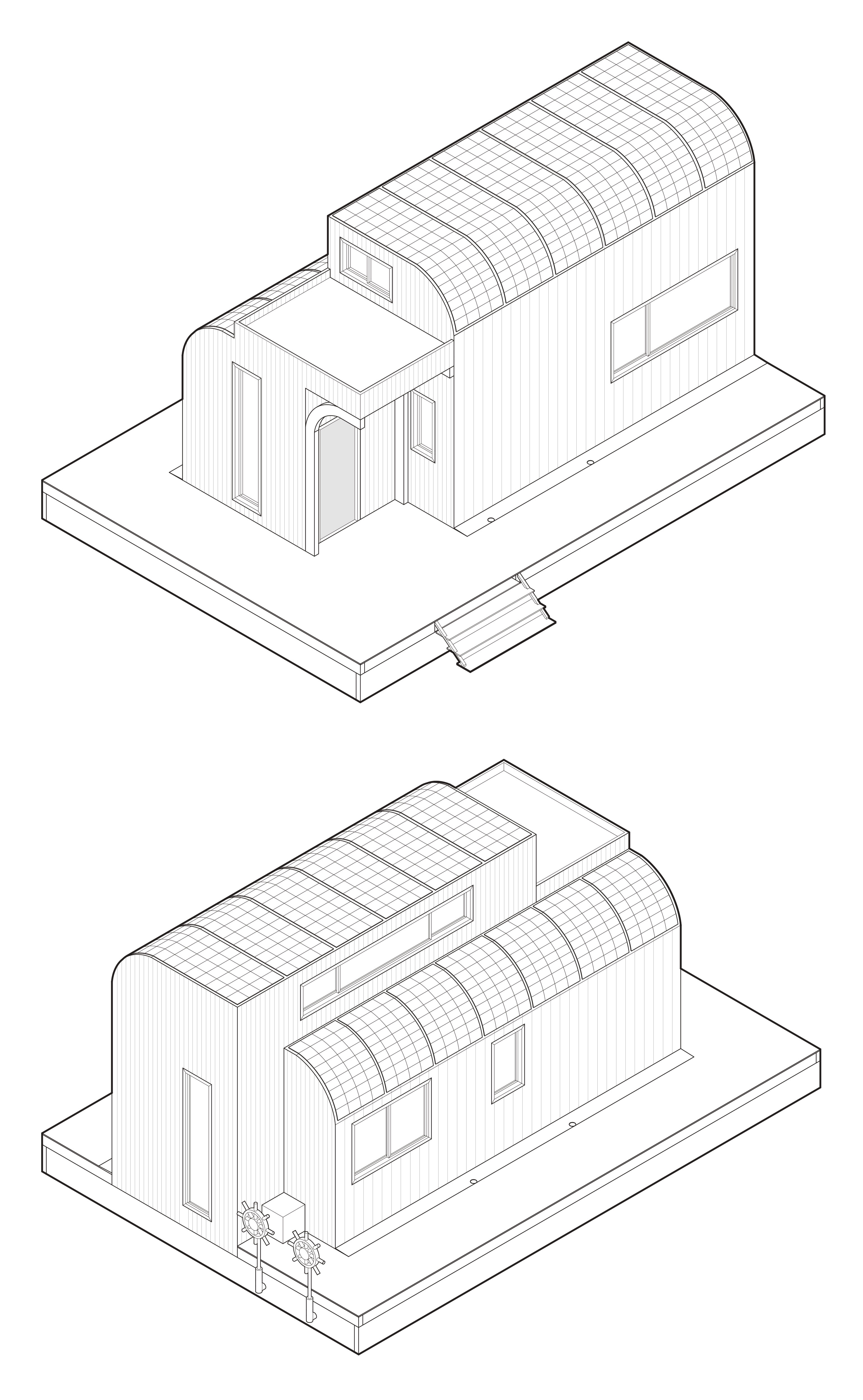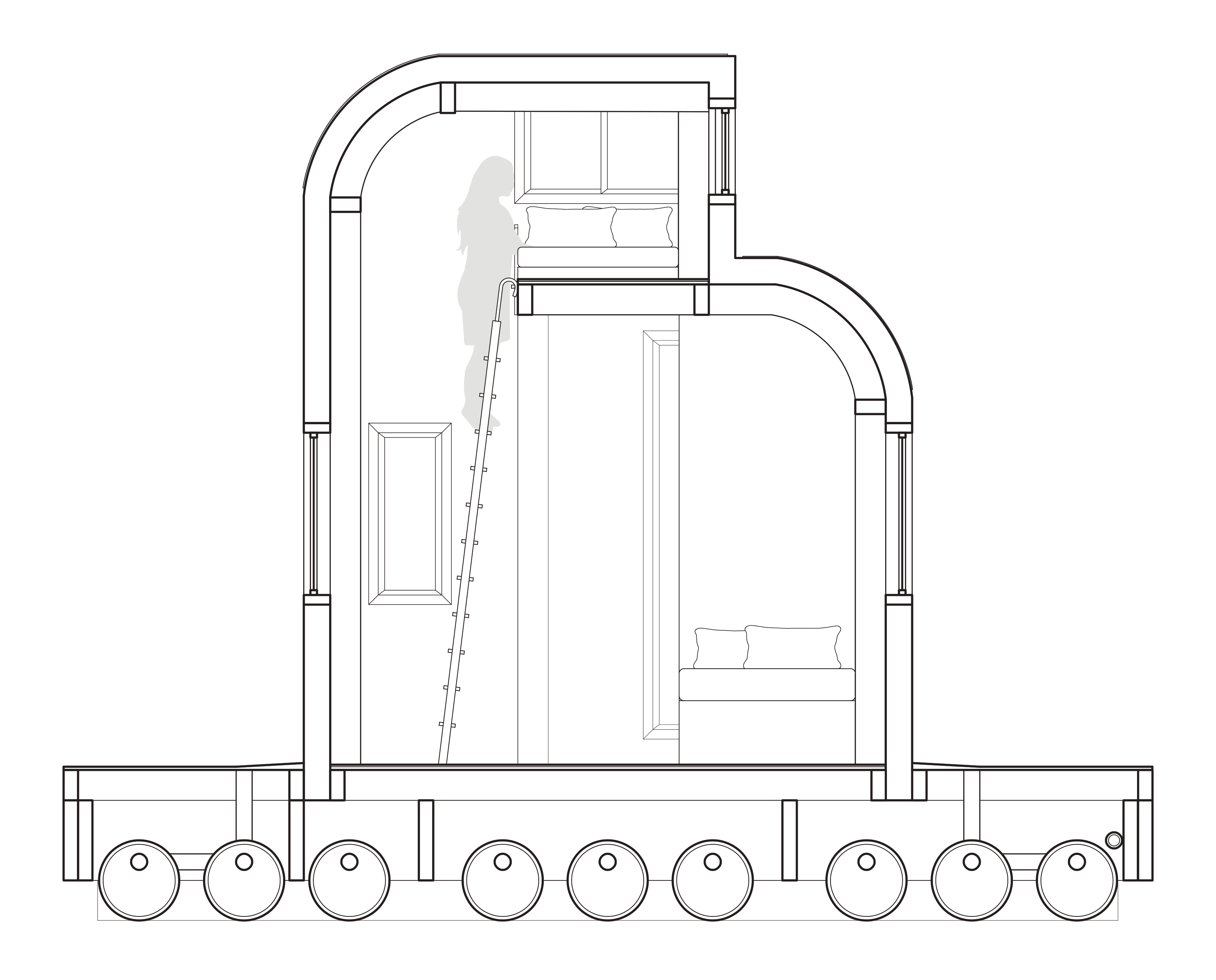UNDERGRADUATE
Kathlynn Hoang—Stewart Crawford Travel Award
![]()
Kathlynn Hoang—Stewart Crawford Travel Award

About the Award
To recognize academic achievement and provide financial assistance to a student who is undertaking curriculum based travel.
Temporary Dwelling
This temporary one-bedroom shelter comes in highly mobilized components to assemble together to create a dwelling that can sit on both land and water. The dwelling works to provide comfort and safety to occupants in three areas of focus for each. Regarding comfort, it is the comfort of having a space to take shelter, sleep, eat, bathe, and clean; the comfort of being able to house up to six people depending on living and emergency situations; and the comfort of living in a controlled temperature with adequate air circulation through the use of solar energy, a heat pump, and operable windows. Regarding safety, it is the safety of having a resilient structure that can adapt to sudden changes such as being able to be mobilized to move from areas of social unrest and being able to float on water in response to rising sea levels; the safety of having a space to secure occupants inside and keep unknowns locked outside, and the safety of the dwelling blending into the surrounding environment through the conscious use of wood that is unprovocative and does not stir discontent from others regardless of the demographic of the area the dwelling is stationed.
The dwelling’s form derives from two main curved glulam frames that are offset from each other and at different heights to create distinctive voids for the upper multipurpose space, rooftop garden, a canopy for the entrance, and a defined area to employ the anchor winch system. The structure utilizes glulam and the finishes are of wood to minimize the dwelling’s embodied carbon. Furniture and millwork are also of wood, with the storage bed, folding dining table, and underfloor storage creating an efficient use of space. Solar energy and a heat pump are implemented to reduce the dwelling’s operational carbon intensity and the rainwater harvesting system removes the need to rely on a local water treatment facility that generates carbon emissions from pumping water. The result is a self-sustaining wooden shelter with its own power and water supply.
In Gratitude
During the upcoming summer semester, I have the opportunity to attend the Tecahnical University of Munich (TUM) as an exchange student, where I wish to obtain a new foundation in my understanding of architecture to progress both my academic and professional career.
Travelling to different countries is valuable when obtaining an architectural degree. The need to be self-sufficient and adapt in an unknown environment acts as a catalyst for academic and personal development due to being fully immersed in the academia and culture of the host country. Learning from professors with different upbringings, knowledge, and experiences gives greater insight into the world’s limitless ideas and concepts. Additionally, exchange provides the opportunity to build long-lasting connections that will form a foundational support once a professional architectural career is pursued. I have learned a lot from my peers and professors at Toronto Metropolitan University (TMU), and I am excited to have the same opportunity in Munich as part of my educational journey.
I am grateful to have been selected as the recipient of the Stewart Crawford Travel Award, which highlights the value of travel in the Architectural Science program and supports my exchange opportunity.
To recognize academic achievement and provide financial assistance to a student who is undertaking curriculum based travel.
Temporary Dwelling
This temporary one-bedroom shelter comes in highly mobilized components to assemble together to create a dwelling that can sit on both land and water. The dwelling works to provide comfort and safety to occupants in three areas of focus for each. Regarding comfort, it is the comfort of having a space to take shelter, sleep, eat, bathe, and clean; the comfort of being able to house up to six people depending on living and emergency situations; and the comfort of living in a controlled temperature with adequate air circulation through the use of solar energy, a heat pump, and operable windows. Regarding safety, it is the safety of having a resilient structure that can adapt to sudden changes such as being able to be mobilized to move from areas of social unrest and being able to float on water in response to rising sea levels; the safety of having a space to secure occupants inside and keep unknowns locked outside, and the safety of the dwelling blending into the surrounding environment through the conscious use of wood that is unprovocative and does not stir discontent from others regardless of the demographic of the area the dwelling is stationed.
The dwelling’s form derives from two main curved glulam frames that are offset from each other and at different heights to create distinctive voids for the upper multipurpose space, rooftop garden, a canopy for the entrance, and a defined area to employ the anchor winch system. The structure utilizes glulam and the finishes are of wood to minimize the dwelling’s embodied carbon. Furniture and millwork are also of wood, with the storage bed, folding dining table, and underfloor storage creating an efficient use of space. Solar energy and a heat pump are implemented to reduce the dwelling’s operational carbon intensity and the rainwater harvesting system removes the need to rely on a local water treatment facility that generates carbon emissions from pumping water. The result is a self-sustaining wooden shelter with its own power and water supply.
In Gratitude
During the upcoming summer semester, I have the opportunity to attend the Tecahnical University of Munich (TUM) as an exchange student, where I wish to obtain a new foundation in my understanding of architecture to progress both my academic and professional career.
Travelling to different countries is valuable when obtaining an architectural degree. The need to be self-sufficient and adapt in an unknown environment acts as a catalyst for academic and personal development due to being fully immersed in the academia and culture of the host country. Learning from professors with different upbringings, knowledge, and experiences gives greater insight into the world’s limitless ideas and concepts. Additionally, exchange provides the opportunity to build long-lasting connections that will form a foundational support once a professional architectural career is pursued. I have learned a lot from my peers and professors at Toronto Metropolitan University (TMU), and I am excited to have the same opportunity in Munich as part of my educational journey.
I am grateful to have been selected as the recipient of the Stewart Crawford Travel Award, which highlights the value of travel in the Architectural Science program and supports my exchange opportunity.






